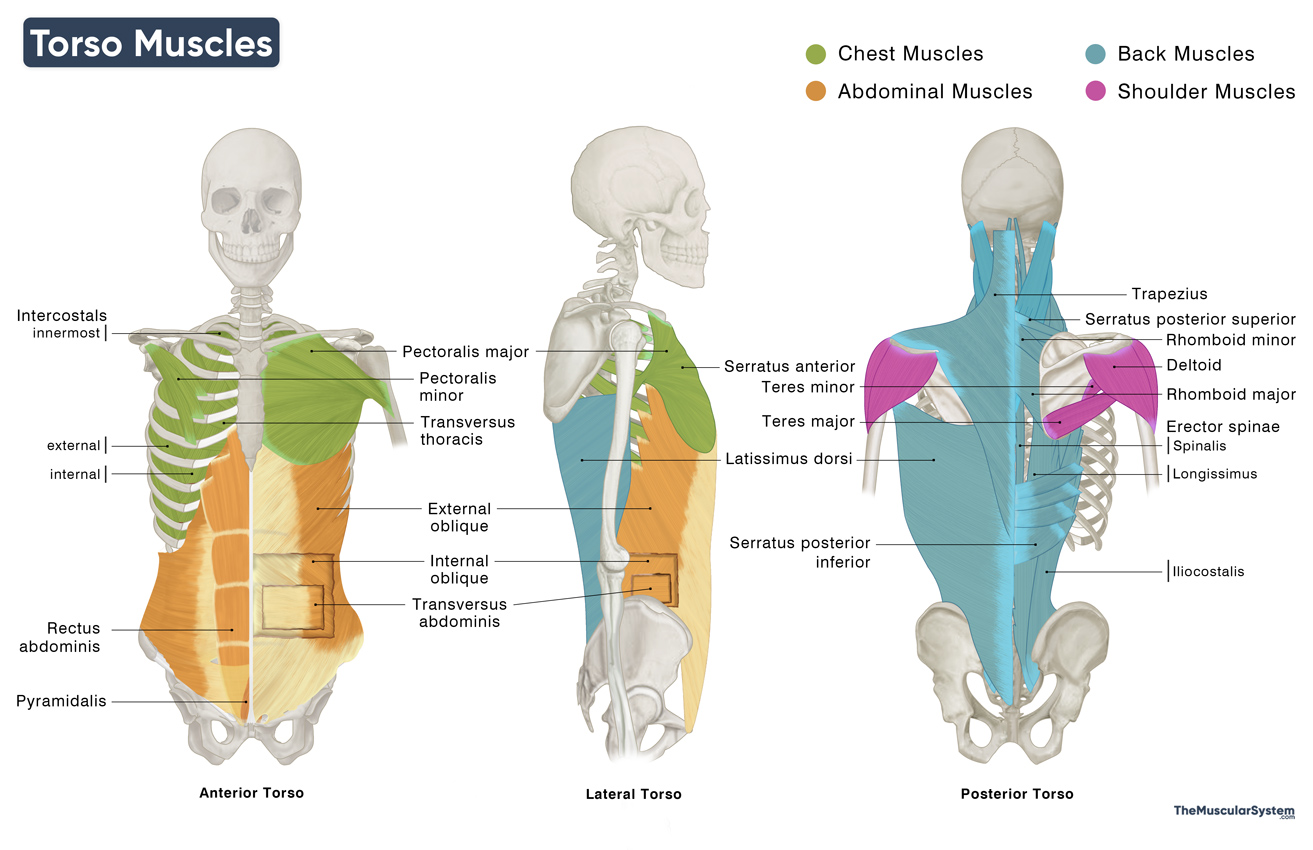Torso Muscles
The torso or body trunk is the largest and central part of the human body, to which the neck and limbs are connected. It holds most of the major organs in the body, including the heart, lungs, intestines, liver, and sexual organs. In fact, the brain is the only major organ that is not located within the torso.
It houses some of the most vital muscles responsible for maintaining posture, supporting the spine, enabling breathing, and facilitating a wide range of movements. The torso muscles include both large, visible muscles, like the pectorals and abdominis muscles, as well as deep, stabilizing muscles that lie closer to the spine and organs, like the diaphragm and erector spinalis.
These muscles work together to provide strength, flexibility, and protection for internal systems, playing a crucial role in nearly every motion we make, from sitting upright to twisting, lifting, and even breathing.
List of Torso Muscles
Anatomically, the torso includes the following muscles based on the regions they are located in:
At the front:
At the back
All these regions are interconnected, yet each contains its own functional and structural muscle groups that are impossible to list in one place. The following are the muscles that are structurally and functionally most important for the torso or trunk.
Muscles That Form the Anterior, Lateral, and Posterior Sides of the Torso
Here is a list of the primary muscles forming the front, sides, and back of the torso. These mainly involve the largest and often superficially located muscles of the chest, abdomen, and back.
| Name | Part of Torso it Forms | Location in the Body |
|---|---|---|
| Pectoralis minor | Anterior torso | Chest |
| Intercostals | Anterior torso | Chest |
| — External Intercostals | – | – |
| — Internal Intercostals | – | – |
| — Innermost Intercostals | – | – |
| Transversus thoracis | Anterior torso | Chest |
| External oblique | Anterior and lateral torso | Abdomen |
| Internal oblique | Anterior and lateral torso | Abdomen |
| Transversus abdominis | Anterior and lateral torso | Abdomen |
| Rectus abdominis | Anterior torso | Abdomen |
| Pyramidalis | Anterior torso | Abdomen |
| Serratus anterior | Lateral torso | Chest |
| Pectoralis major | Lateral torso | Chest |
| Latissimus dorsi | Lateral, and posterior torso | Back |
| Trapezius | Posterior torso | Back |
| Rhomboid major | Posterior torso | Back |
| Rhomboid minor | Posterior torso | Back |
| Serratus posterior superior | Posterior torso | Back |
| Serratus posterior inferior | Posterior torso | Back |
| Erector spinae group | Posterior torso | Back |
| — Spinalis | – | – |
| — Longissimus | – | – |
| — Iliocostalis | – | – |
| Deltoid* | Posterior torso | Shoulder (upper arm) |
| Teres major* | Posterior torso | Shoulder (upper arm) |
| Teres minor* | Posterior torso | Shoulder (upper arm) |
Primary Torso Movements and the Muscles Involved
| Movement | Description | Muscles Involved |
| Flexion | Bending your torso forward, like when touching your toes | Rectus abdominis, internal obliques, external obliques |
| Extension | Arching your back or bending backward | Erector spinae group |
| Lateral Flexion | Bending your torso to the side, like reaching down your leg.# | Internal obliques, external obliques, quadratus lumborum, erector spinae |
| Rotation | Twisting your upper body to the side, like looking behind you | Internal obliques, external obliques, transversospinales group |
| Stabilization/Compression | Bracing your core to keep your torso steady, like during a plank | Rectus abdominis, external oblique, transversus abdominis, multifidus, pelvic floor muscles |
References
- Muscles of the Torso: ScienceDirect.com
- Muscles of the Trunk:Kenhub.com
- Anterior Muscles: Libretexts.org
- Muscles of the Anterior Trunk: Libretexts.org
- Muscles of the Trunk: Training.Seer.Cancer.gov






